In the intricate web of international trade regulations, even the most seemingly mundane products are assigned a specific classification under the Harmonized System (HS) code. Among these are cutting discs – unassuming yet indispensable tools in various industries, from construction to metal fabrication. Let’s delve into the realm of cutting discs and unravel their HS code to understand their classification in global trade.
Deciphering Cutting Discs
Before delving into the labyrinth of HS codes, let’s first grasp the essence of cutting discs. These discs, also known as cutting wheels or blades, are precision tools designed to slice through various materials with efficiency and accuracy. Whether it’s metal, concrete, stone, or ceramics, cutting discs come in a myriad of shapes, sizes, and compositions to suit different applications.
The Harmonized System (HS) Code: An Overview
The Harmonized System (HS) is an internationally standardized system for classifying traded products, developed and maintained by the World Customs Organization (WCO). Each product is assigned a unique HS code, which serves as a universal language for customs authorities worldwide to classify goods for taxation, regulatory, and statistical purposes.
Cracking the HS Code for Cutting Discs
Cutting discs are categorized under Chapter 68 of the Harmonized System, which encompasses “Articles of Stone, Plaster, Cement, Asbestos, Mica or Similar Materials.” Specifically, cutting discs fall under subheading 6804.21. The HS code for cutting discs may vary slightly depending on factors such as material composition, dimensions, and intended use.
Considerations in Classification
While the general classification for cutting discs is apparent, nuances exist that can influence their HS code. Factors such as the material used in the disc’s composition (e.g., bonded abrasives, diamond-tipped, or ceramic), dimensions (e.g., diameter, thickness), and intended application (e.g., metal cutting, concrete cutting) may impact classification.
Trade Implications
Understanding the HS code for cutting discs is paramount for international trade. Importers and exporters must accurately classify their products to comply with customs regulations and determine applicable tariffs and duties. Additionally, a clear comprehension of the HS code streamlines cross-border transactions, mitigating the risk of delays and penalties associated with misclassification.
Conclusion
Though often overlooked, cutting discs are vital components in various industries, enabling precision cutting and shaping of materials. Their classification under the HS code facilitates seamless international trade, ensuring compliance with customs regulations and fostering smoother transactions across borders. So, the next time you’re involved in sourcing or shipping cutting discs, remember the significance of their HS code in navigating the complex landscape of global commerce.



